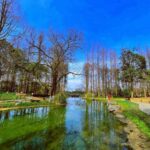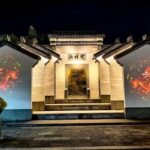Changxing Badu Kuai Scenic Area, formerly known as the Shi Li Ancient Ginkgo Long Corridor, is located in Xiaopu Badu Kuai, Changxing County, and is one of the three ancient ecological wonders of Changxing County. The entire corridor stretches about 12.5 kilometers long and varies in width from 5 kilometers to 500 meters, with 30,000 native wild ginkgo trees scattered throughout, including more than 2,700 trees that are over a hundred years old.
Apart from being renowned for its ginkgo trees, Badu Kuai also has a particularly long cultural history. It is said that during the Han Dynasty, Liu Xiu hid from pursuers here eight times, hence the name Badu Kuai. The Wuzhan Mountain inside the valley was a向往之地 for ancient star diviners, and the tomb of Yang Zhonggeng is located on the mountain. The valley is flanked by green mountains with clear streams running through it, and various residential buildings are nestled among the ginkgo groves, creating a tranquil environment with the sounds of chickens and dogs.

Ginkgo is a descendant of the ginkgo plant and is one of the oldest genera among existing seed plants. There is only one family, one genus, and one species in the existing ginkgo order, and it is a rare plant under national second-level protection. Currently, only a few wild and semi-wild ginkgo trees remain in China, specifically in the Xitianmu Mountain area of Zhejiang, the Shennongjia area at the junction of Sichuan and Hubei, and the Dabie Mountain area bordering Henan and Anhui.

The scenic area is open all year round from 08:00 to 17:00. Essential Tips for Visiting: [Premium Service Information] Changxing Badu Kuai Scenic Area’s Shi Li Ancient Ginkgo Long Corridor includes exclusive personal guidance and one-on-one full journey planning.

Changxing Badu Kuai Scenic Area
Changxing Badu Kuai Scenic Area, formerly known as the Shi Li Ancient Ginkgo Long Corridor, is locat[...]









